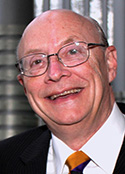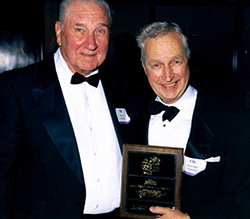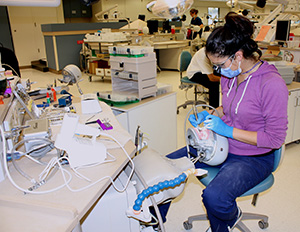 Dr. Paul Robertson was Dean of the School of Dentistry from1992 to 2001. After continuing to teach in the Department of Periodontics, he retired at the end of spring quarter 2014.
Dr. Paul Robertson was Dean of the School of Dentistry from1992 to 2001. After continuing to teach in the Department of Periodontics, he retired at the end of spring quarter 2014.
Dentistry’s ties with the School of Medicine: I think dentistry tends to be isolationist, and most dental schools across the United States are isolated from the other schools on the campus – they just train dentists and that’s it. This school was established at exactly the same time as the medical school, and as a result the relationships between the medical school and dental school were excellent and remained excellent – so excellent that in fact when the search proceeded for the [current] medical dean, Paul Ramsey, I was named chair of the search committee as dean of dentistry. … It’s a very good example of how much interaction there was between the two schools.
Becoming a research powerhouse: Roy Page, Beverly Dale, Tim DeRouen, Sam Dworkin, Sue Herring and their colleagues contributed in a major way to make this the number-one research dental school. All held joint appointments in Medicine or other Health Science schools. Moreover, Roy Page insisted that all faculty contribute to research in some way. Linda LeResche [currently Associate Dean for Research] is still trying to keep that movement going.
Stability in the deanship: I think Karl (Dr. Karl-Åke Omnell, his predecessor, who served from 1981 to 1992) and I had a similar outlook about the importance of trying to combine teaching and research and patient care and public service. That was a role that gave the school stability and the faculty a chance to pay attention to their teaching and research rather than be involved in the political upheaval [that the School faced in the 1970s].
A dean’s constituencies: I worked for the faculty, I worked for the patients, I worked for the students, I worked for the [UW] president through the provost, I worked for government agencies, I worked for the Food and Drug Administration, and keeping all of those constituencies happy is a full-time job. … I tried to go to every district dental society meeting every other year so that I could be in Kitsap and Yakima and Spokane, because the School of Dentistry represented the state and had students from all over the state. …[At the outset of his deanship,] the alumni just reached out and welcomed me, just hugged me, and made me feel like I was home.
Life in the old lab: The old laboratory was stainless steel, flat, tables as far as you could see. It got way too hot in the summer with all the Bunsen burners and it got way too cold in the winter because all the seals on all the windows were failing. … In all fields, people realized that we needed to move more and more toward learning how to do things on a simulator that was close to a human being, as close to a human being as possible. At the same time, the D1 lab was in shambles. It was dirty, it was unhealthy, it had students there at 3 o’clock in the morning.


Dr. Robertson credits fellow former Dean Karl-Åke Omnell (right, with the late Dr. Johnny Johnson, ’55) with laying the groundwork for the successful renovation of the D-1 Simulation Laboratory.
Karl should get all the credit [for the new D-1 lab, which was built during Dean Robertson’s tenure]. He got the university to give him about half a million dollars to have a study conducted of the dental school facility, which had been built in the 1940s. … So Karl had an outside, unbiased group, architects and engineers, come in and survey this place and make recommendations on how it could be upgraded in situ.
So when I arrived, Karl had a road map all laid out for me, and one of the major recommendations was that a whole new simulation and bioengineering approach be taken to the D1 laboratory. Make it multi-use. There wasn’t even internet to everybody’s office when I arrived here at the dental school! There were just stations where there was internet. So the place had fallen behind in a physical sense. Well, I used Karl’s work – submit to upper campus, through upper campus, to the Legislature for seed money for the D1 lab and other clinical areas that were serving the public – DECOD, for example, which was unique. And they gave me something over $3 million. And I took that, and they hinted that I needed to do everything I could do to match it.
The campaign was a resounding success and we did very well, and not only did we totally demolish the D1 lab and put in the simulators, we also put in internet lines in every office. [Other changes included] new rugs, paint, new lights, new dental chairs, new technology, new equipment and then as a faculty, everyone got excited doing that.
Dr. Charles Bolender (then Chair of Prosthodontics): Chuck Bolender chaired the D-1 planning and construction. He was way ahead in educational processes. He had an honors program. He took seniors who were really interested in prosthodontics, made them honor students. They then would meet quarterly with the whole faculty at a nice dinner and they’d talk about new and innovative approaches. And those honor students would pay back by teaching, coming back the next year and teaching. Every one of them did it. And so the prosthodontics clinic which used to be located on D-4 was filled with these new graduates who were Chuck’s honor students. And everybody jumped on that bandwagon.
“We had the top percentile on national boards. We had 1,000 applicants for 50, 60 positions. It’s like when the Huskies were headed to the Rose Bowl.”
Era of good feeling: People felt good about the school. Educationally and clinically, we were highly ranked in the country and the number-one research dental school. … And I could go out and talk to the alumni who had been here during the hard times and say we had a 100 percent pass rate on the regional boards. We had the top percentile on national boards. We had 1,000 applicants for 50, 60 positions. It’s like when the Huskies were headed to the Rose Bowl.
I think part of it was that I really enjoyed it. The chairs of the departments were not my chairs, they were my friends. And we’d argue over most major decisions, but we were all friends, and we’re friends today, and I enjoyed it. And my own research was going well and then I became the coordinator of Health Sciences. … We were an equal partner with Medicine, with Nursing and with Arts and Sciences and Engineering and so it was just a good time, just a happy, good time.
They offered me a third term and I said, “You know, I’ve had 10 years and I enjoyed every minute of it.” With another five years, I don’t think I would do as good a job, because it’s a hard job. And so I was lucky on both ends. I arrived at exactly the right time and I left at exactly the right time.